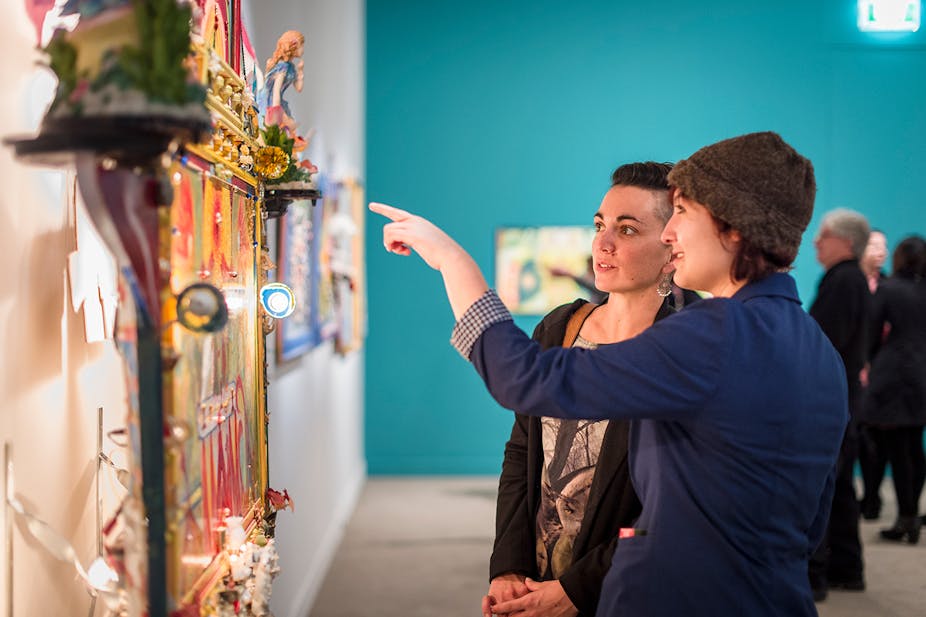In Talking Point, the Australia Council’s recently published “snapshot” of the Australian contemporary visual arts in 2014, it was surprising to find only one reference to the country’s 42 university based art galleries and museums and no interviews with any of their professional staff.
Described as an overview of the “vibrant and diverse ecology” of Australian visual arts it nevertheless ignores 26% of the country’s public art museums. These galleries and museums collectively care for important and valuable collections, spend in excess of A$6million annually on acquiring the work of Australian artists and mount 250 exhibitions each year.
It’s hard to imagine how any mapping of the cultural terrain of Australia could ignore such a significant topographical feature.

Although mentioned briefly as “an untapped resource” with the potential to offer partnership on more ambitious and long-term projects, there is no acknowledgement in the report of the substantial contribution made by university-based museums and galleries.
So what do the country’s university art museums contribute to their host institutions and more broadly to the Australian community?
Since their establishment more than 150 years ago, universities in Australia have commissioned and collected artworks to enrich their cultural milieu and ensure their graduates develop as fully rounded individuals, with a balanced education that includes a knowledge of the arts through contact with their own and other cultures.
Additionally, universities have acknowledged their responsibility as agents in building civic responsibility and social capital, helping communities to better understand and celebrate their cultural heritage.

That two-fold mission of providing a centre for teaching and research while concurrently enriching community life continues to guide the development of programs within university-based museums and galleries. Certainly over the past decade the inclusion of new galleries when refurbishing or constructing facilities for art schools and the opening of purpose-built or renovated gallery spaces on university campuses is evidence of a continuing commitment to their mission as custodians and interpreters of our visual culture.
University art galleries are in an excellent position to critically engage with different ideas, and to offer a vision beyond the local while providing a critical appreciation and interpretation of local beliefs.
One way they can do this is through their collections, which focus a particular lens on the local by creating a repository of artefacts and images that documents aspects of community life and activity that might otherwise be overlooked.
The universities of Australia are a national treasure-trove. Their holdings constitute a significant quota of the nation’s cultural heritage and through their annual program of exhibitions, supported by publications and scholarly research, they are a vibrant component of Australia’s cultural life.

My own university – the University of Western Australia – is a case in point. Its art collection originated from the acquisition of books and artworks by Professor Walter Murdoch while on a trip to Europe in 1927, with funds provided by the Hackett Bequest. The purchase of art works began in earnest in the late 1940s, and the University maintains its commitment to purchasing contemporary art.
The Berndt Museum was founded on the donations of Professor Ronald Berndt and his wife Catherine and its collection has continued to grow through donations and acquisitions.
Together with the Cruthers Collection of Women’s Art, donated to the University in 2007, these three collections constitute more than 16,000 artworks and artefacts and in excess of 35,000 photographs.
To grow and showcase these holdings the University, through its museum and gallery, commissioned new work by 13 Australian artists and presented 12 exhibitions, 11 featuring the work of Australian artists, in 2013. These exhibitions were supported by the publication of two books, two journals and ten catalogues and the professional staff in the museum and gallery presented 57 public program events and hosted 118 tour visits by internal and external school groups.
It is regrettable that this level of engagement, which is replicated in university-based museums and galleries around the country, is not acknowledged for its significant contribution to the commissioning, acquisition, research and presentation of Australian contemporary visual arts practice.

Certainly one talking point that arises from this recent report is how did the authors overlook such a body of evidence when investigating the “diverse ecology” of the Australian contemporary art community?
Established in 2008, University Art Museums Australia (UAMA) is an affiliated group of art museum professionals who each has direct responsibility for an Australian university art museum. Its primary objective is to advocate on behalf of university-based museums and galleries to create a greater understanding of their impact in building and maintaining a dynamic and sustainable visual arts sector in this country.
The Talking Point report reinforces the urgency of that task.

